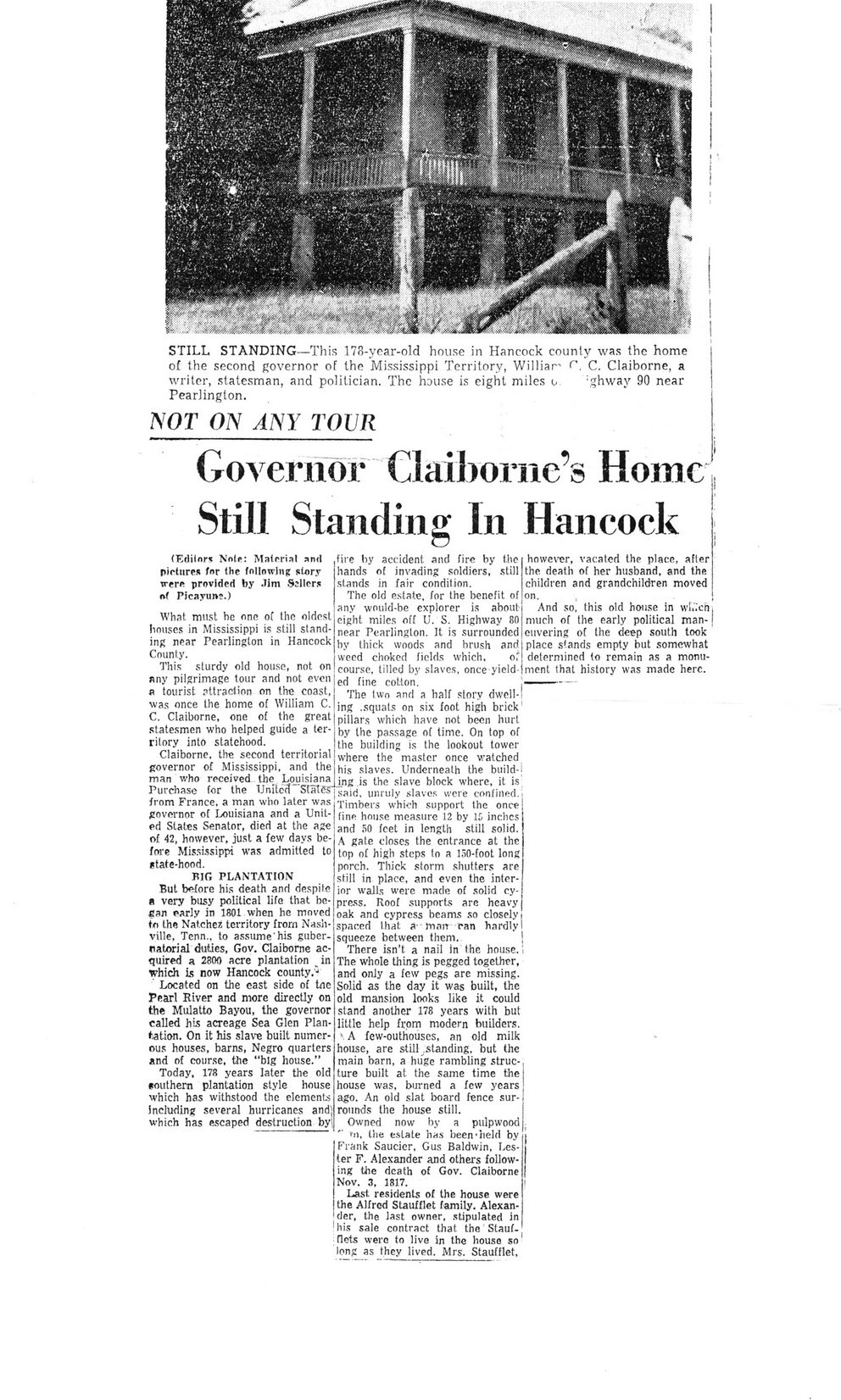This text was obtained via automated optical character recognition.
It has not been edited and may therefore contain several errors.
STILL STANDING?This 178-year-old house in Hancock county was the home of the second governor of the Mississippi Territory, William C. Claiborne, a writer, statesman, and politician. The house is eight miles o :ghway 90 near Pearlington. NOT ON ANY TOUR Governor Claiborne?s Home Still Standing In Hancock (Eflilnr* Note: Material and pictures for (he following story were provided by Jim Sailers of Picayun;.) What must he one of tho oldest houses in Mississippi is still standing near Pearlington in Hancock County. This sturdy old house, not on any pilgrimage tour and not even b tourist attraction on the coast, ?was once the home of William C. C. Claiborne, one of the great statesmen who helped guide a territory into statehood. Claiborne, the second territorial governor of Mississippi, and the man who received the Louisiana Purchase for the Uniter!"States'^ from France, a man who later was governor of Louisiana and a United States Senator, died at the age of 42, however, just a few days before Mississippi was admitted to *tate-hood. BIG PLANTATION But before his death and despite a very busy political life that be-*>an parly in 1801 when he moved to the Natchez territory from Nashville, Tenn., to assume'his gubernatorial duties, Gov. Claiborne acquired a 2300 acre plantation h in which is now Hancock county Located on the east side of tne Pearl River and more directly on the Mulatto Bayou, the governor called his acreage Sea Glen Plantation. On it his slave built numerous houses, barns, Negro quarters and of course, the ?big house.? Today, 178 years later the old southern plantation style house which has withstood the elements including several hurricanes and] which has escaped destruction by! fire by accident and fire by the hands of invading soldiers, still stands in fair condition. The old estate, for the benefit of any would-be explorer is about eight miles off U. S. Highway 80 near Pearlington. It is surrounded by thick woods and brush and weed choked fields which, o,* course, tilled by slaves, once yielded fine cotton. , The two and a half story dwell-1 ing .squats on six foot high brick' pillars which have not been hurt by the passage of time. On top of the building is the lookout tower where the master once watched his slaves. Underneath the build-j ing is the slave block where, it is' said, unruly slaves were confined. however, vacated the place, after the death of her husband, and the children and grandchildren moved on. And so, this old house in wii.'ch, much of the early political man- i euvering of the deep south took place stands empty but somewhat determined to remain as a monument that history was made here. Timbers whk-h support the once fine house measure 12 by 15 inchcs and 50 feet in length still solid. A gate closes the entrance at the top of high steps to a 150-foot long porch. Thick storm shutters are still in place, and even the interior walls were made of solid cypress . Roof supports are heavy oak and cypress beams so closely spaced that a1 mnrr ran hardly I squeeze between them. 1 There isn?t a nail in the house. The whole thing is pegged together, and only a few pegs are missing. Solid as the day it was built, the old mansion looks like it could stand another 178 years with but little help from modern builders. \ A few-outhouses, an old milk house, are still .standing, but the main barn, a huge rambling structure built at the same time the house was, burned a few years ago. An old slat board fence surrounds the house still. Owned now by a pulp wood rn, the estate has been'held by Frank Saucier, Gus Baldwin, Lester F. Alexander and others following the death of Gov. Claiborne Nov. 3, 1817. Last, residents of the house were the Alfred Staufflet family. Alexander, the last owner, stipulated in his sale contract that the Stauf-flets were to live in the house so long as they lived. Mrs. Staufflet,

Claiborne, J.F.H Claiborne-J.F.H-096